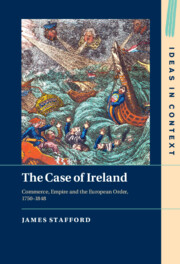Book contents
- The Case of Ireland
- Ideas in Context
- The Case of Ireland
- Copyright page
- Dedication
- Contents
- Acknowledgements
- Introduction
- Chapter 1 The Enlightenment Critique of Empire in Ireland, c. 1750–1776
- Chapter 2 Commerce without Empire?
- Chapter 3 Property, Revolution and Peace, 1789–1803
- Chapter 4 Enlightenment against Revolution
- Chapter 5 The Granary of Great Britain
- Chapter 6 Democracy, Nationality and the Social Question, 1815–1848
- Conclusion
- Bibliography
- Index
Chapter 2 - Commerce without Empire?
‘Free Trade’ and ‘Legislative Independence’, 1776–1787
Published online by Cambridge University Press: 27 January 2022
- The Case of Ireland
- Ideas in Context
- The Case of Ireland
- Copyright page
- Dedication
- Contents
- Acknowledgements
- Introduction
- Chapter 1 The Enlightenment Critique of Empire in Ireland, c. 1750–1776
- Chapter 2 Commerce without Empire?
- Chapter 3 Property, Revolution and Peace, 1789–1803
- Chapter 4 Enlightenment against Revolution
- Chapter 5 The Granary of Great Britain
- Chapter 6 Democracy, Nationality and the Social Question, 1815–1848
- Conclusion
- Bibliography
- Index
Summary
This chapter explores the high hopes for Irish commerce that were aroused by the American Revolution, and their complex interactions with British attempts to reform and consolidate the remnants of its mercantile empire following its American debacle. Irish campaigns for ‘free trade’ and ‘legislative independence’ were animated by the hope that the liberation of the Kingdom’s foreign trade would enable it to chart its own course in a more peaceful Europe. This vision clashed fundamentally with a rival, British reform agenda, embodied in William Pitt the Younger’s unsuccessful Irish Commercial Propositions of 1785, which balanced an extension of imperial trading privileges to Ireland with its closer integration into the British market. The rejection of Pitt’s proposals by the Irish parliament, after their heavy modification by British slaving and manufacturing interests, produced an unstable equilibrium, dominated by patronage and executive power, that was ripe for criticism by the more radical forces that would take up the fallen mantle of Irish ‘patriotism’ in the 1790s.
Keywords
- Type
- Chapter
- Information
- The Case of IrelandCommerce, Empire and the European Order, 1750–1848, pp. 59 - 99Publisher: Cambridge University PressPrint publication year: 2022

